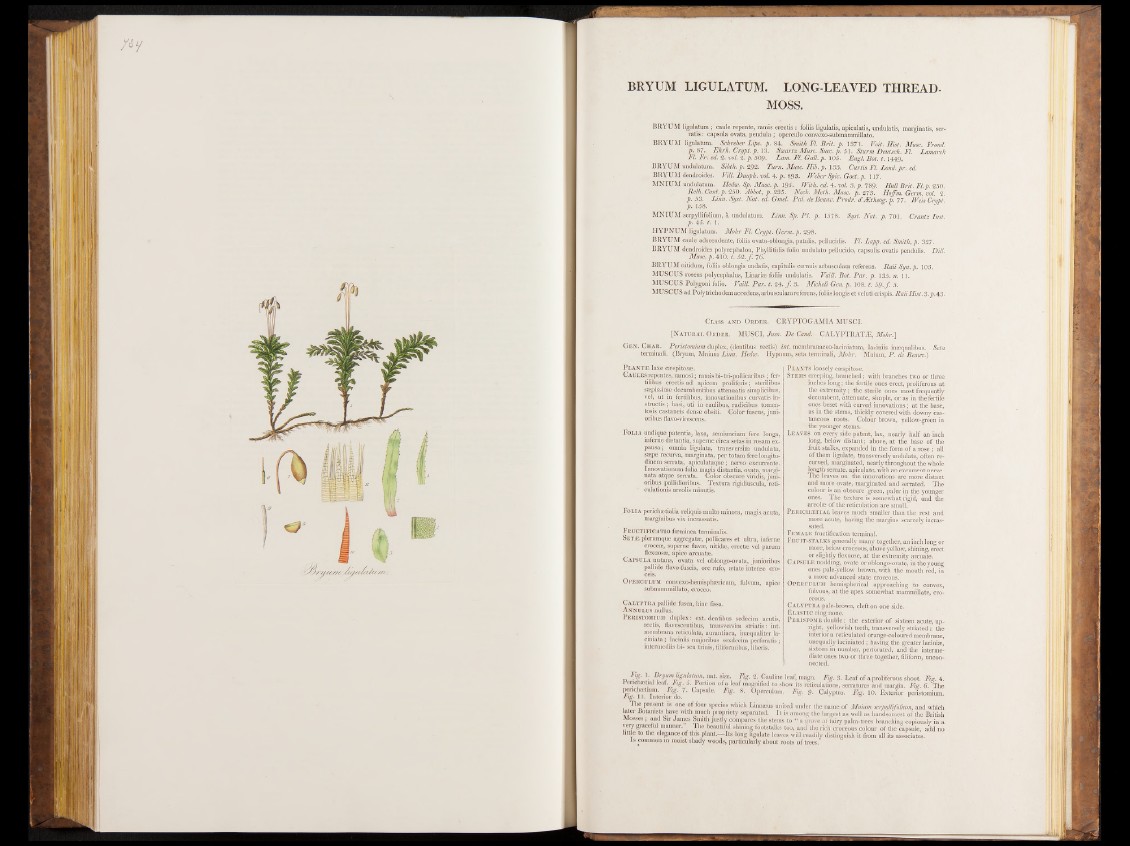
BRYUM LIGULATUM. LONG-LEAVED THREAD-
MOSS.
BRYUM ligulatum ; caule repente, ramis erectis : foliis ligulatis, apiculatis, undulatis, marginatis, ser-
ratis : capsula ovata, pendula ; operculo convex'o-submammillato.
BRYUM ligulatum. Schreber Lips. p. 84. Smith Fl. B r it. p. 1371. Voit. Hist. Muse. Frond.
p. 87. Ehrh. Crypt, p. 13. Swartz M use. Suec.p. 51. Sturm Deutsch. Fl. Lamarck
Fl. Fr. ed. 2. ml. 2.p . 509• Lam. Fl. Gall.p. 105. Engl. Bot. 1 .1449.
BRYUM undulatum. Sïbth.p. 292. Turn. Muse. Hib .p . 133. Curtis F l. Lond.pr. ed.
BRYUM dendroides. Fill. Dauph. ml. 4. p.'893. Weber Spic. Goet.p. 117.
M N IUM undulatum. Hedw. Sp. Musc.p. 195. With. ed. 4. ml. 3. p. 789. Hull Brit. Fl.p. 250.
Relh. Cant.p. 250. Abbot, p. 235. Neck. Meth. Muse. p. 273. Hoffm. Germ. ml. 2.
p- 53. Linn. Syst. Nat. ed. Grnel. Pal. de Beauv. P rodr. d’Ætheog. p. 77. Weis Crept
p. 158. * • *
M N IUM serpyllifolium, 5. undulatum. Linn. Sp. PI. p. 1578. Syst. Nat. p . 701. Crantz Inst.
p . 4 5 . t . l .
H Y PN UM ligulatum. Mohr Fl. Crypt. Germ. p. 298.
BRYUM caule adscendente, foliis ovato-oblongis, patulis, pellucidis. Fl. Lapp. ed. Smith, p. 327.
BRYUM dendroides polycephalon, Phyllitidis folio undulato pellucido, capsulis ovatis pendulis. Dill.
Muse. p. 4 1 0 -1. 52. ƒ 76.
BRYUM nitidum, foliis oblongis undatis, capitulis cernuis arbusculam referens. R aii Syn. p. 103.
MUSÇUS roseus polycephalus, Linariæ foliis undulatis. Vailt. Bot. Par. p. 135.«. l l .
MUSCUS Polygohi folio. Vaill. P a r. t. 24. f . 3. Micheli Gen. p. 108. t. 59. f . 5.
MUSCUS ad Polytrichodemaccedens, arbusculam referens, foliis longis et veluti crispis. Raii Hist. 3.p. 43.
Class and Order. CRYPTOGAMIA MUSCI.
[N atural Order. MUSCI, Juss. D e Cand. CALYPTRAT7E, Mohr.]
Gen . Char. Peristomium duplex, (dentibus rectis) int. membranaceo-laciniatum, laciniis inasqualibus. Seta
terminali. (Bryum, Mnium Linn. Hedw. Hypnum, seta terminali, Mohr. Mnium, P . de Beauv!)
Plant.® laxe caespitosaj.
Caules repen tes, ramosi; ramis bi- tri-pollicaribus ; fer-
tilibus erectis ad apicem proliferis; sterilibus
ssepissime decumbentibus attenuatis simplicibus,
vel, ut in fertilibus, innovationibus curvatis in-
structis; basi, uti in caulibus, radicibus tomen-
tosis castaneis dense obsiti. Color fuscus, juni-
oribus flavo-virescens.
Folia undique patentia, laxa, semiunciam fere longa,
inferne distantia, superne circa setas in rosam ex-
pansa; omnia ligulata, transversim undulata,
Sffipe recurva, mai’ginata, per totam fere longitu-
dinem serrata, apiculataque; nervo excurrente.
Innovationum folia magis distantia, ovata, margi-
na.ta atque serrata. Color obscure viridis, juni-,
oribus pallidioribus. Textura rigidiuscula, reti-
• culationis areolis minutis.
.Folia perichtetialia reliquis multo minora, magis. acuta,
marginibus vix incrassatis.
FroCTiFieat-io foeminea terminalis.
Set® plerumque aggregate, poTlicares et ultra, inferne
croceas, superne flavee, nitidaj, erect® vel parum
flexuos®, apice arcuatce.
Capsula nutans, ovata vel oblongo-ovata, junioribus
pallide flavo-fuscis, ore rufo, ®tate intense cro-
Operculum convexo-hemispbfericum, fulvum, apice
submammillatö, croceo.
Calyptra pallide fusca, hinc fissa.
Annulus nullus.
Peristomium duplex: ext. dentibus sedecim acutis,
rectis, flavescentibus, transversim sti-iatis: int.
membrana reticulata, aurantiaca, in®qualiter la-
ciniata; laciniis majoribus sexdecim perforatis j
intermediis bi- seu trims, filiformibus, liberis.
Fig. 1. Bryum ligulatum, nat. size. Fig. 2. Cauline
Perichrotial leaf. Fig. 5. Portion of a leaf magnified to si
perichffitium. Fig. 7. Capsule. Fig. 8. Operculum.
Fig. 11. Interior do.
The present is one of four species which Linnieus uni
later Botanists have with much propriety separated. It
Mosses; and Sir James Smith justly compares the stems
very graceful manner.” The beautiful shining footstalks
little to the elegance of this plant.—Its long Hgulate leav
Is common in moist shady woods, particularly about r
Plants loosely casspitose.
Stems creeping, branched; with branches two or three
inches long; the fertile ones erect, proliferous at
the extremity; the sterile ones most frequently
decumbent, attenuate, simple, or as in the fertile
ones beset with curved innovations; at the base,
as in the stems, thickly covered with downy cas-
taneous roots. Colour brown, yellow-green in
the younger stems.
Leaves on every side patent, lax, nearly half an inch
long, below distant; above, at the base of the
fruit-stalks, expanded in the form of a ro se ; all
of them ligulate, transversely undulate, often recurved,
marginated, nearly throughout the whole
length serrate, apiculate, with an excurrent nerve.
The leaves on the innovations are more distant
and more ovate, marginated and serrated. The
colour is an obscure green, paler in the younger
ones. The texture is somewhat rigid, and the
areolse of the reticulation are small.
Perich®tial leaves much smaller than the rest and
more acute, having the margins scarcely incras-
sated.
Female fructification terminal.
Fruit-stalks generally many together, an inch long or
more, below croceous, above yellow, shining, erect
or slightly flexuose, at the extremity arcuate.
Capsule nodding, ovate or oblongo-ovate, in the young
ones pale-yellow brown, with the mouth red, in
a more advanced state croceous.
Operculum hemispherical approaching to convex,
fulvous, at the apex somewhat mammillate, croceous.
Calyptra pale-brown, cleft on one side.
Elastic ring none.
Peristome double: the exterior of sixteen acute, up-
right, yellowish teeth, transversely striated : the
interior a reticulated orange-coloured membrane,
unequally laciniated ; having the greater lacinias,
sixteen in number, perforated, and the intermediate
ones two or three together, filiform, unconnected.
leaf, magn. Fig. 3. Leaf of a proliferous shoot. Fig. 4.
iow its reticulations, serratures and margin. Fig. 6. The
Fig. 9■ Calyptra. Fig. 10. Extenor peristomium.
ted under the name of Mnium serpyllifolium, and which
is among the largest as well as handsomest of the British
to “ a grove o f fairy palm-trees branching copiously in a
too, and the rich croceous colour of the capsule, add no
3s will readily distinguish it from all its associates,
aots of trees.